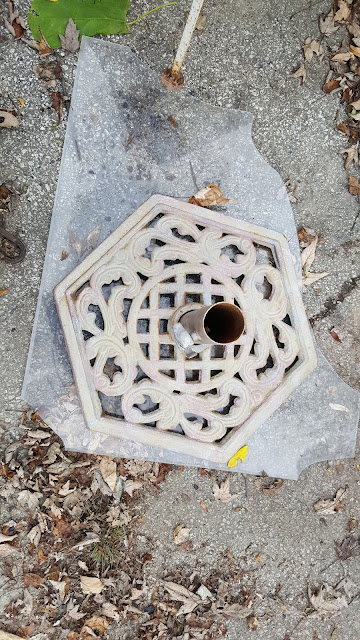It is this time of year that I curse my black walnut trees. I can work around the fact that I cannot plant certain plants within 50 ft of a walnut tree because my trees are huge and give us great shade during those hot summer months. But come September and October it is a whole different story.
On Monday I spent 3 straight hours sweeping the driveway and then using a snow shovel to pick up 5 trash cans full of walnuts, walnut leaves and the tiny stem that held the leaves. Unfortunately, that was only the tip of the walnut iceberg.
I know that you are probably thinking "why didn't she rake them up every week, so that there wasn't so many to pick up at one time?" I tried that method the second year after we purchased the house. I was raking under a large walnut tree when one fell and landed directly on my collar bone and just missing my head.
That walnut left a 4 inch wide purple bruise with a black center the exact size of the walnut. It hurt for weeks. I've had other close calls but I have learned to not walk under the walnut trees if the wind is blowing or if the trees are heavily laden with walnuts like this year.
One of those close calls was two weeks ago. I was sitting on a concrete bench drinking a Tim Horton's ice capp. I really thought I was out of range and I wasn't paying any attention to anything but that ice capp when a walnut fell and destroyed my cup and then hit my thigh.
The walnut had enough speed/ velocity/ or whatever, that it was able to destroy a plastic cup and still leave a bruise on my thigh.
I've had people ask why I don't wear a hard hat? I would need a hard hat with a 2 foot brim around the entire helmet to protect my body....and I don't think they make such a thing.
So that leaves me raking like a mad man once the majority of the walnuts have fallen from the tree. My method is to rake them into piles and then shovel them into trash cans.
The above photo is of the largest walnut tree. We raked and shoveled all afternoon and only picked up 1/2 of the walnuts. There are 15 trash cans with walnuts in them, sitting on the curb waiting for the trash guys on Wednesday.
There are 3 more large trees and 2 small trees that need picking up. I will say that the crop of walnuts is unusually large this year. Some years there are very few or they are small. It all depends on when the last frost occurs and if there is ample rain early in the season. So the same conditions that ensure that we have a heavy crop on our fruit trees are also the same conditions that make an abundance of LARGE black walnuts.
The reason we are in a rush to pick them up is because we need a tree trimmer to cut some large branches out of our trees. If we leave the walnuts on the ground someone will break an ankle. Plus, I cannot mow the lawn when it's covered in black walnuts. It is bad for the blades and it's a bumpy ride.
What about our other trees? The leaves have only fallen off the ash and walnut trees. The sugar maples are just starting to turn red and bright orange. The black and silver maples, sycamore, red/burr/pin oaks, catalpas, and tulip poplars still have green leaves and it is the middle of October.
They better fall fast because I can't imagine raking leaves in November.
Reuse Repurpose Recycle


































